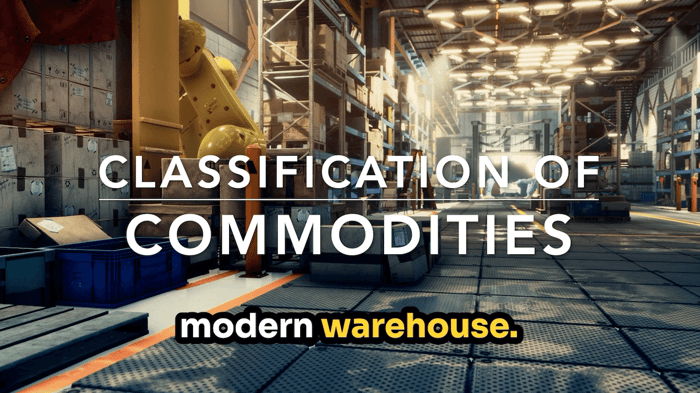No Products in the Cart

Warehouse Safety by Design: Understanding NFPA 13 Commodity Classification
In the world of warehousing and logistics, safety is beyond a priority - it is a necessity. "Understanding NFPA 13 Commodity Classification" means that effective warehouse design and operations hinge on understanding fire and life safety codes, standards and regulations. This begins with commodity classification under NFPA 13, Standard for the Installation of Sprinkler Systems. This classification system, published by the National Fire Protection Association (NFPA), plays a pivotal role in determining fire protection requirements, sprinkler system design, storage methods, and overall facility layout.
In "Understanding NFPA 13 Commodity Classification" we will explore NFPA 13’s classification of commodities, its impact on warehouse safety, and how proper implementation ensures compliance and fire risk mitigation. The importance of commodity classification is a fundamental. It is an aspect of warehouse fire and life safety because it establishes the level of fire protection necessary for different types of stored goods.
The NFPA 13 classification system is designed to assess the fire risk posed by various materials based upon their composition, packaging, and storage exposure. Below is a breakdown of the different classes and their defining characteristics:
Class I Commodities present the least fire hazard. These materials are generally non-combustible and are either stored on wood pallets or within single-layer corrugated cartons. Examples include:
Class II Commodities are slightly more combustible than Class I due to their packaging, which may include multi-layer corrugated cartons or plastic shrink-wrapping. Examples include:
Class III Commodities contain moderate amounts of combustible materials, such as wood, paper, and natural fibers. These products often include minimal plastic content. Common examples are:
Class IV Commodities contain higher levels of plastic and combustibles than Class III. They can include materials that incorporate plastic packaging or are partially composed of plastic. Examples include:
"Understanding NFPA 13 Commodity Classification" also means understanding plastics.
Plastics Classification
Groups A, B, and C plastic commodities can pose a greater fire risk compared to traditional Class I-IV materials. NFPA 13 categorizes plastics into three groups based on their combustibility:
Group A Plastics (Highest Fire Risk)
These plastics are considered the most hazardous due to their high heat release rates and difficulty in suppression. Group A plastics include:
Group B Plastics (Moderate Fire Risk)
These materials are less combustible than Group A but still require careful fire suppression planning. Group B plastics include:
Group C Plastics (Lowest Fire Risk)
These plastics present the lowest fire hazard and are comparable to Class III commodities. Group C Plastics include:
Special Considerations for Storage and Protection
Certain materials require unique fire suppression strategies beyond the NFPA 13 classifications. For example, plastic pallets can significantly impact fire load and suppression needs. Warehouses using plastic pallets should conduct a deeper evaluation within NFPA 13 to determine necessary protection measures.
The NFPA 30 Flammable and Combustible Code governs the classification and storage of flammable and combustible liquids based on their flashpoints, boiling points, and ability to sustain combustion. Example materials include:
Flammable liquids are divided into categories based on flashpoint and boiling point, with Class IA and IB being the most volatile with a flashpoint <73°F (23°C). Warehouse operators must ensure proper containment and ventilation when storing these materials.
Aerosol Products (see NFPA 30B) pose additional fire risks due to their pressurized nature. The most hazardous aerosols contain flammable propellants as well as flammable base products. Their hazard level is classified based upon their respective heats of combustion:
Examples include spray insecticides, lubricants, and paints. Considerable fire research by the consumer and aerosol products industry led to the development of the protection schemes found within the NFPA 30B Code for the Manufacture and Storage of Aerosol Products.
A unique area essential to understanding NFPA 13 commodity classification involves oxidizers and corrosives. For example, you'll also need to refer to the NFPA 400 Hazardous Materials Code which applies to oxidizers such as sodium hypochlorite (bleach) and calcium hypochlorite, commonly found in pool chemicals. These materials can react violently when exposed to heat or incompatible substances. Proper segregation from flammable liquids is crucial. Corrosive substances like muriatic acid and organic peroxides (MEK peroxide) also require special storage precautions to prevent hazardous reactions.
"Understanding NFPA 13 Commodity Classification" means that the role of fire protection systems in warehousing is not one-size-fits-all. Once commodities are classified, the appropriate storage method and design, including commodity density via rack, palletized, automated retrieval, etc., must be determined. The storage and retrieval design must also relate directly to the fire suppression system in order to be effective.
NFPA 13 outlines several further considerations. For example, different commodity classifications require different sprinkler types, such as Early Suppression Fast Response (ESFR) or in-rack sprinklers. Other variables include:
Commodity classification under NFPA 13 is an essential component of warehouse safety. Proper classification ensures the right fire protection measures are in place, mitigating risks and enhancing compliance with safety standards.
As businesses strive for operational efficiency, prioritizing fire and life-safety remains non-negotiable. By understanding the NFPA 13 classification system and implementing best practices, warehouses can create a safer working environment while protecting assets and personnel.
For more information on warehouse safety solutions, visit MightyLineTape.com and explore ways to enhance safety through floor marking and 5S organization strategies.
In the meantime, stay informed, stay compliant, and most importantly - stay safe!